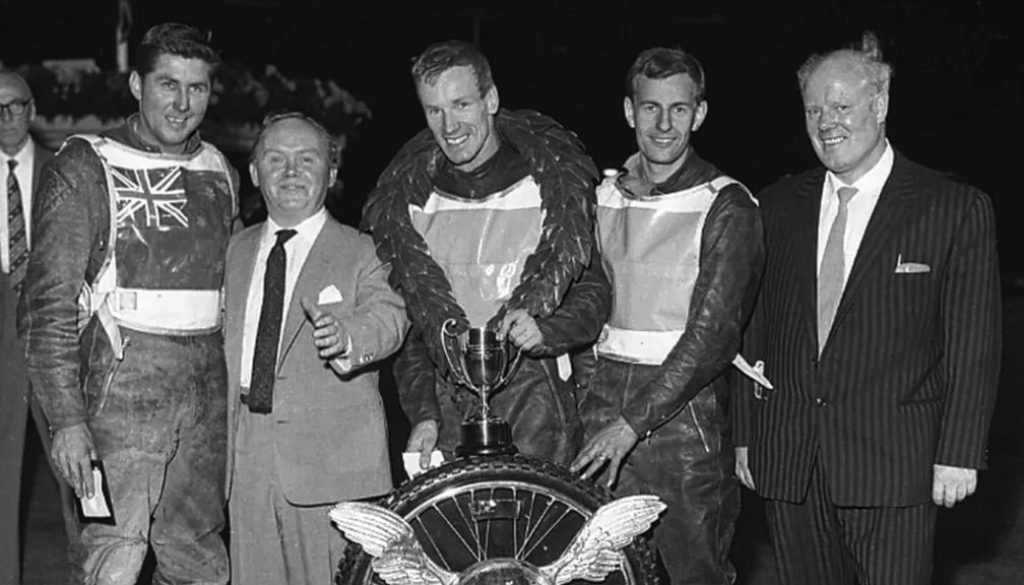STARS OF THE CENTURY: OVE FUNDIN INTERVIEW
Interview by FIMSpeedway.com
In the year speedway marks its 100th anniversary, the sport’s oldest living world champion Ove Fundin celebrates his own big milestone – turning 90 on May 23.
The Swedish great has won it all. He’s a five-time FIM Speedway world champion, topping the podium in 1956, 1960, 1961, 1963 and 1967. Along with Aussie icon Jason Crump, he holds the record for the longest unbroken run in the world’s top three – spending 10 straight seasons on the World Final rostrum from 1956 to 1965.
Legend is one word that could describe the Flying Fox. Pioneer is another. He was the first world champion from outside the English-speaking world, and he won the first editions of both the FIM Speedway World Team Cup and FIM Speedway World Pairs with his country. Today’s FIM Speedway World Cup trophy is named in his honour.
In the first of FIMSpeedway.com’s Stars of the Century interview series to celebrate speedway’s 100th season, we caught up with Ove Fundin to reflect on his iconic career …
Ove, you made history as the first world champion from outside the English-speaking nations like Britain, Australia, USA and New Zealand. How did you get into speedway in Sweden?
“I started off when I was about 16 – that’s when you could get a motorcycle licence in Sweden. I started off doing motocross because motocross was getting very popular after the Second World War. Nearly all of the motorcycles we used were dispatch bikes imported from Germany after the war.
“I did motocross for two years and I was spotted by someone from Linkoping – that’s the nearest speedway track to where I was born. He came up to me and said ‘I can see from your style of riding that you should try speedway. We will fix you up with a bike and some leathers as well if you come over to one of our practice nights.’
“I jumped at that. I had never been to a speedway meeting, but I had heard a little bit about it. They loaned me a bike and I seemed to get the hang of it straight away.
“I was only there twice and then my father helped me to buy a bike. I was immediately accepted as a reserve for the team. In the first meeting I attended, one of the riders got hurt, so they gave me a ride for nearly all of the meeting. I did so well that after that, I was never a reserve again.”
How did speedway become popular in Sweden?
“They called speedway ‘dirt track’ in Sweden. It caught on quite early. We had Swedish speedway riders even before the Second World War.
“After the war, it took a while because there was a shortage of speedway bikes. There were only a few bikes in the whole of Sweden. You couldn’t import any because there were restrictions on anything to do with engines. There was also a shortage of fuel.
“Three or four years before I started, there was this man in Sweden called Arne Bergstrom. He went over to England and saw speedway there. He realised that to improve the sport and make it more interesting, you had to start a league and have teams. He introduced that, which was a few years before I started racing. Arne was the man behind Swedish speedway.
“Speedway always was and still is run by clubs. It has never been run by a promoter. Most of the people involved in it are volunteers.
“The riders got paid from when they started speedway – not very much, but we got paid for what we were doing. Otherwise, it would have just been a rich man’s sport. It was also unheard of that anyone had more than one bike.”
Now even riders in the sport’s lower leagues have at least two bikes …
“When I came to Norwich in the UK, they gave me a spare bike to ride. Throughout all my years, I never owned a bike in Britain. Here in Sweden, I had a bike that belonged to me.
“Otherwise, the bikes I rode in Britain belonged to Norwich Speedway. During all my trips to Australia and New Zealand, I never brought a bike. They gave me one to ride. I used to bring my handlebars – that was all.
“You may have seen pictures of the way we used to carry our bikes. We just put them in the boot of the car and that went for everyone, whether you were a world champion or just a junior.”
Winning one World Final was hard enough. Topping the podium in five and reaching the rostrum 10 times in a row is some feat.
It’s often debated whether or not it’s harder to win the Speedway GP World Championship over 10 rounds than it was to win the one-day World Finals staged up to 1994. What’s your view?
“People who don’t know much about the days of the one-day World Finals don’t realise that you didn’t just have to win a one-day Final. You had to qualify to be there.
“In my case, I had to qualify in Sweden, then in Scandinavia and then in Europe. If you didn’t make it in any of those qualifying rounds, you were out. The way they run Speedway GP today, you can miss a meeting completely and still become world champion. In my day, if I was world champion, I still had to qualify to come to the next World Final.”
Was there a year when you missed out on qualification?
“In 1966, I was supposed to do one qualifying round in Leningrad or St Petersburg, as it is known now. I never had time to get the visa for the USSR. I thought that the organisers had done that because they always did when I went into a communist country back then.
“I flew over to take part and I was refused entry to the country. I took the plane back to Sweden and when I arrived in Stockholm, they said ‘everything is arranged – jump on the next plane and come over.’ But I was so angry about it that I said, ‘to hell with it!’”
In that case, you could have made it 12 years in a row on the podium because you won title No.5 in 1967. Did you ever feel the pressure of keeping your run of World Final podiums going? Did it become harder from year to year?
“Not really – I loved what I was doing. I enjoyed it all the time. Most of us raced for the love of the sport, and to win of course.”
How was the racing schedule back then? Today’s riders increasingly opt to race in fewer and fewer league matches alongside their Speedway GP commitments.
“Today I often read about riders complaining that they are racing too often. They race about 60 or 70 meetings in a year. I raced about 120 meetings every year. I rode every meeting that I was offered.
“I had to go home to Sweden and race every Sunday because Sunday was the big day for speedway here in Sweden.
“After the Sunday, I might be back at Wimbledon on a Monday. I rode every day of the week. Every year I rode from 1954 until I retired, I rode in New Zealand or Australia too.
“The first trips I did there were by boat. First, I took the boat to London, and then I went from London to Australia. We travelled through the Suez Canal, but I also travelled through the Panama Canal to go to New Zealand.”
That’s some ride and it was not just the FIM Speedway World Championship that you won along the way. You were part of the Swedish team that won the first FIM Speedway World Team Cup in 1960, as well as the first FIM Speedway World Pairs in 1968.
“We had a very strong team in Sweden. In the first few times that the World Cup was run, the British team included Australians and New Zealanders. They got riders from everywhere – from the Commonwealth countries.
“Barry Briggs was in it. Ronnie Moore was in it. Even so, the team from Sweden managed to win a few World Cups when it was first introduced.”
Of all the riders you have raced and watched over the years, who was your favourite and why?
“Ronnie Moore – without a doubt. I loved the way he rode the bike. I liked the way he was as a person too. He was always very friendly.”
And Ronnie was a two-time world champion – the first from New Zealand. What about today’s Speedway GP riders? Who catches your eye?
“I met Dan Bewley in Malilla at the Swedish round last year. I had seen him on TV a few times as well.
“When I meet the young ones now, I have to introduce myself because they don’t know about us older ones.
“But I said to him ‘remember that Jason Crump and I were redheads – gingers just like you are. You have something to defend.’”
Dan won two Speedway GPs in Cardiff and Wroclaw last season. Could he become the next rider to make it 10 seasons in a row on the podium?
“I wouldn’t be surprised at all. His attitude to speedway reminds me very much of mine. It’s not only the red hair we have in common. I hope he will not follow the other riders and ride less. On the contrary, I think you should ride as often as you can. That way, you never have to practise.”





WOFFINDEN AIRLIFTED TO HOSPITAL AFTER CRASH IN POLAND